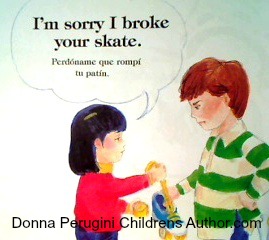Part 2 Teaching Your Child to Apologize
Part Two of Teaching Your
Child to Apologize
If a rule is broken,
lay out the terms of the consequence before the rule is broken. Make it age appropriate. I have a lot of my own pottery in our home. As grandparents, the grandchildren were raised to respect the pottery and not throw things around in the house. The hallway was the designated throwing area. (Respect for property) Their parents watched them and also reinforced our rules.
If breakage was totally accidental, we showed we were sad about the breakage (I put away the really good pottery from baby to 4) and if it was intentional with throwing items (like for the dog) I would talk with them, have them see how it hurt me, apologize and they cleaned it up. Then they would not get to play inside with the dog for the rest of the visit, but outdoors. Part of the consequence was next visit the dog not available for them to play with. For age awareness, they were old enough to know not to throw in the house and knew what the consequences would be. If they were very young, all the pottery was put away from ‘grab heighth’.
Be consistent in enforcing your rules
I know it’s been a long day and you’d rather sit on the couch relaxing with your spouse, but you are the enforcer of your rules. You can’t let the rules slide one day and be enforced loudly the next. That’s known as inconsistent discipline…typically yelling from the sofa at the offender and not re-enforcing your rules with consequences that you have already told them about. I know, I lived it.
It’s a process:
- Give your rules,
- give your consequences for broken rules,
- enforce firm and fair consequences for broken rules.
Your child begins to understand this process and sees that, when they do right, they reap good. When they do wrong, they reap negative results. “It is this sense of morality that helps the child understand the need for an apology.” taken from The 5 Languages of Apology
Apologies can bring friends back
If they are siblings in your family and are establishing a history of not apologizing, it will creep in to their relationships with everyone. Eventually they will lose friendships and even closeness within the family. Their siblings will begin to block them out in different ways. Apologies strengthen relationships.
Learn and teach all 5 apology languages
So why not learn all of the five languages of apology? If you can teach your child all five, they’ll be able to apologize and have their apology received by anyone.
A simple level of apology for a 2 year old would be, “I’m sorry”(for whatever they did).
Or if an older child knocks over their cup on purpose, “I pushed over my cup. I’m wrong”. The apology expresses regret and takes responsibility for his actions.
An older sister tosses her little sister’s doll clothes all over the room making little sister cry. “I’m sorry, I should not have done that. I’ll pick it all up now and won’t do it again. Will you forgive me?”
You see how from early (2 years old) a child can express regret. As they grow older (six years old), they learn to string words together in an apology covering,
- expressing regret,
- accepting responsibility,
- making restitution,
- genuinely repenting and
- requesting forgiveness.
This is learning to speak the language of apology starting as a little child up to an older child. You teach them, ‘thank you’, ‘you’re welcome’ and ‘please’ and see they are capable of using those words. As they grow they comprehend why they use those words and when to use the words appropriately. It’s the same for the language of apology.
Modeling the languages of apology for your child
Another way is to model the languages of apology. Remember Fonzie (played by Henry Winkler) on Happy Days? He could never say he was ‘Wr-wro-wrrrr.” WRONG! He believed his manhood would be diluted or squashed if he apologized, thereby acknowledging that he was wrong. Adults really can have a problem in this area with their children. Some believe if they apologize for something they did wrong to their child that they would show weakness. Children have a way of accepting and moving on with sincere apologies from their parents. Letting your child understand it was hard for you to apologize but you were able to do it anyway is excellent modeling!
Share this post with your friends…or Pin it on Pinterest!!
Leave your comments on how you have been working on teaching your children apologizing. How successful have you been so far?








I think that showing an example of apologies can be one of the best ways to teach your children how to learn and grow from their mistakes. Sometimes, however, I wonder if my kids really feel remorse when they say sorry just because they are supposed to, not because they really want to repent.
-CK
CK,
You’re doing all the right things to teach your children and their feelings of remorse will follow, especially the older they get.
Even though that may be exactly what is going on (about not feeling remorse for what they did), they are still children and how many little children really mean ‘thank you’ when they’re just learning as a toddler? It’s just something you learn to say at first and then you understand it better as you grow.
Have you tried adding in the other apology languages with ‘I’m sorry’? It may help them understand that the person they are apologizing to has been harmed. “I’m sorry, how can I make it better?”
What I’m saying is ‘I’m sorry’ is good for the littlest ones and then add in more as they become older. Along with your teaching how they harmed another, you can add in the more lengthy apology. Hearing themselves say ‘how can I make it better?’ means the child may need to make restitution also for what they did.
It works for adults too…I just had to apologize at work. It was not easy to do, but I had made a mistake and the apology needed to be done. The response was more gracious than I had imagined.
In my mind, I was going to be drawn and quartered. But my apology was accepted and some of the responsibility was shared.
I was amazed. Lessons can be learned at any age. 🙂
Kipp recently posted..Mystery meat
There’s a test in the book that helps you understand what you accept as an apology. When my husband and I discussed it he started apologizing to me that way.
I can honestly say that it was much easier to be gracious as the receiver of an apology when it’s believeable. Like you mentioned in your comment, it makes it easier to accept some of the responsibility too.